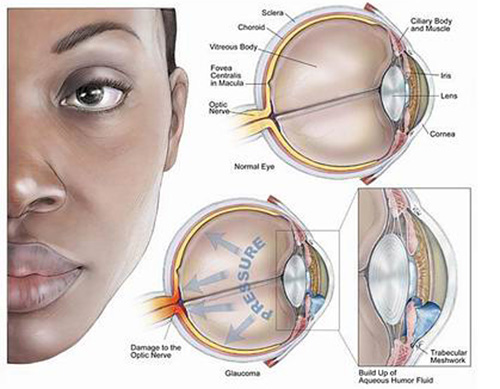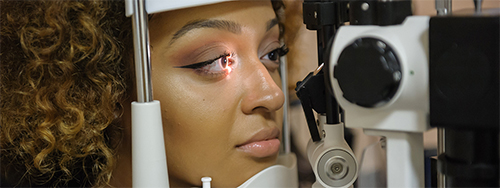
By Daniel Laroche MD
What is Glaucoma? Glaucoma is a disease of the eye characterized by three components:
- Damage and loss of the retinal ganglions cells and optic nerve described as cupping
- Loss of visual field
- Usually increased eye pressure (the mean normal eye pressure is 15mmHG)
Glaucoma is a leading cause of blindness in the world today. There are over 80,000 people that go blind from glaucoma every year in the US. It is the leading cause of preventable blindness in African Americans and people from the Caribbean. Cataracts are the most identifiable cause of glaucoma.

People at risk for glaucoma include the elderly, Blacks, people with elevated eye pressure, primary relatives with glaucoma, persons with high myopia, high hyperopia, history of eye trauma, and diabetes. Blindness from glaucoma is insidious.
In most cases, there is no pain, and the loss of vision occurs slowly from peripheral to central. The central reading vision is not affected until the end thus most people do not realize it until they have lost a substantial amount of their peripheral vision. In low or normal pressure glaucoma the central vision may be affected first.

The elevated intraocular pressure damages the optic nerve both mechanically and creates decreased blood flow to the eye. The most identifiable cause of glaucoma is the enlarged lens or cataract in the eye. Early cataract surgery and trabecular bypass has become the best option to stop vision loss in patients with glaucoma in my practice.
The current use of eyedrops and laser help to lower intraocular pressure but do not address the causative mechanism of the glaucoma being the enlarged lens. Incisional cataract surgery and glaucoma surgery is often needed to truly stabilize glaucoma.

All people should be screened regularly for glaucoma as part of a medical eye exam. Screening should consist of an eye examination consisting of gonioscopy (examination of the drainage angle), intraocular pressure measurement with goldmann applanation tonometry, and a dilated optic nerve examination.

If there appears to be any damage to the optic nerve or abnormal pressure, then a visual field test should be performed and optic nerve photos taken. Persons with thin corneas should be more aggressively monitored and treated for glaucoma as the disease tends to be worse in these patients.
If you have eye pressure or glaucoma and feel that you may be losing vision, I recommend you seek the care of a glaucoma specialist for a second opinion. DON’T GO BLIND FROM GLAUCOMA!

Dr. Laroche is a board certified ophthalmologist and Glaucoma specialist. Dr. Laroche is the President and Director of Glaucoma Services of Advanced Eyecare of New York with offices located at 215-43 Jamaica Ave, Queens Village, N.Y 11428, (718-217-0424) and at 49 West 127th Street, NY, N.Y (212-663-0473). He is a graduate of New York University, and Cornell University Medical College. He completed his residency in Ophthalmology at Howard University Hospital and specialty training in glaucoma at the New York Eye and Ear Infirmary. He is the inventor of the Intrascleral Ciliary Sulcus Suprachoroidal Microtube Technique to treat Glaucoma. (https://www.youtube.com/watch?v=iEKOj-KJ0oo)

